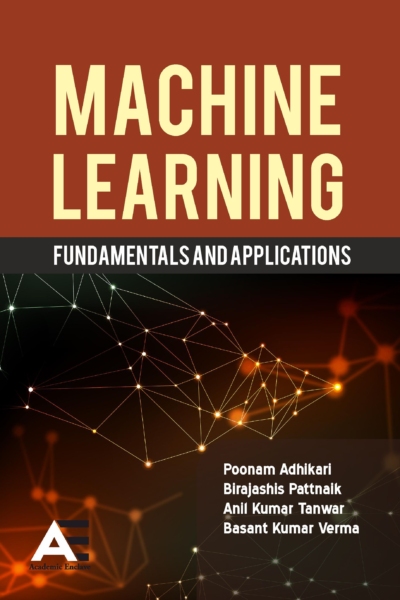Description
About the Book
“Understanding Artificial Intelligence: Fundamentals and Applications” is an essential resource designed for students, educators, and practitioners seeking a solid foundation in the field of Artificial Intelligence (AI). This book aims to demystify core AI concepts such as machine learning, neural networks, data processing, and intelligent decision-making. It introduces fundamental theories alongside real-world examples to help readers grasp the evolving landscape of AI technologies. The book not only provides theoretical knowledge but also emphasizes practical implementations of AI across various domains including healthcare, robotics, education, and industry. With contributions from experienced academicians and researchers, it serves as a bridge between academic study and practical application—making it an ideal companion for learners and professionals who wish to understand and utilize the power of AI in solving real-life problems.
About the Authors
Mr. Sameer Awasthi is currently working in Bansal Institute of Engineering and Technology, Lucknow as an Assistant Professor and Head in Department of Computer Science & Engineering (Artificial Intelligence & Artificial Intelligence and Machine Learning). He is having 21 years of teaching experience. He is completed his MTech. (CSE) from Amity University, Lucknow and B.Tech.(IT) from BBDNITM Lucknow. He has published 12 Journal Papers and 10 conference paper in various reputed international journals. He has published 3 Indian patent and 2 International patents. His area of interest is Artificial Intelligence, Machine Learning, Cloud Computing and Ad-Hoc networks.
Dr. Gaurav Kumar Srivastava is currently working in Pranveer Singh Institute of Technology Kanpur, Uttar Pradesh India. as an Associate Professor in the department of Computer Science and Engineering. He is having 14 year of teaching and research experience. He has completed his Ph.D. from MUIT Lucknow, M.Tech (SE) from BBDU Lucknow and B.Tech (IT) From AKTU, Lucknow His area of research is Artificial Intelligence and Machine Learning. He has given valuable inputs as a guide to 2+ PhD. 4+M.Tech students and 20+ B.Tech students in his career so far. He has published 1 Indian patents and 1 International Patents with Grants. He has published 03 Conferences Papers and 16 Journal Papers in which 7 are in Scopus journal and some are in reputed journals. He is the reviewer of reputed conference and journals.
Dr. Arun Kumar Yadav is currently working in Bansal Institute of Engineering and Technology, Lucknow as an Associate Professor in Department of Electrical Engineering. He is having 16 year of teaching and research experience. He has completed his Ph.D. from Sri Venkateswara University, Gajurla Uttar Pradesh, M.Tech. from NIT Patna Bihar and B.Tech from PIT Jaunpur. He has published various journal and conference papers and his area of interest is Power System.
Ms. Ranjana Rajput is an Assistant Professor at St. Andrews Institute of Technology and Management in Gurugram, where she teaches and researches in the field of computer science. She holds an M.Tech in CSE and has over four years of academic and industry experience. Her favorite subjects include Python programming, Machine Learning, and Data Science, which she is passionate about making accessible and engaging for students and readers alike. Ranjana Rajput is committed to bridging the gap between academic theory and real-world application through her work in artificial intelligence.
Contents
Prefacev
1. Introduction1
Introduction & Objective1
Overview of Artificial Intelligence1
Background & Applications6
Turing Test16
Introduction to Weak AI, Strong AI &Narrow AI20
General Intelligence25
Concept of Super AI27
Rational Agent Approaches to Artificial Intelligence(AI)30
Intelligent Agents& Their Structure34
Introduction to Behavior& Task Environment39
2. Problem Solving and Searching Techniques43
Introduction & Objective43
Introduction to Problem Characteristics44
Concept of Production Systems48
Introduction to Control Strategies58
Breadth-first Search61
Depth-first Search64
Hill Climbing & its Variations68
Heuristics Search Techniques72
Best-first Search, A* Algorithm75
Constraint Satisfaction Problem79
Means-end Analysis81
Introduction to Game Playing83
Min-max & alpha-beta Pruning Algorithms87
3. Knowledge Representation91
Introduction & Objective91
Propositional Logic92
Concept of First-Order Predicate Logic95
Introduction to Resolution Principle99
Concept of Unification102
Introduction to Semantic Nets105
Conceptual Dependencies108
Frames & Scripts111
Production Rules113
Programming in Logic (PROLOG)115
4. Understanding Natural Languages121
Introduction & Objective121
Components and Steps of Communication122
The contrast among Formal & Natural Languages in the
Context of Grammar124
Introduction to Chomsky Hierarchy of Grammars126
Parsing & Semantics129
Concept of Parsing Techniques131
Context-Free & Transformational Grammars137
Recursive & Augmented Transition Nets139
5. AI the Present and the Future145
Introduction & Objective145
AI The Present and the Future146
Concept of Symbolic AI 146
Data-driven AI & Machine Learning150
Machine Learning and Deep Learning based AI 155
Applications of symbolic & data driven AI159
Interpretable & Explainable AI164
Ethics of AI169
Benefits and Risks of AI176
6. Learning and Adaptation in AI185
Introduction & Objective185
Introduction to Learning in AI186
Definition and Importance of Learning in AI187
Categories of learning: Supervised, Unsupervised,
Semi-supervised, and Reinforcement Learning189
Common algorithms191
Common Algorithms: K-Means Clustering, Principal
Component Analysis (PCA), Hierarchical Clustering195
Agents, Environments, Rewards196
Markov Decision Processes (MDPs)198
Q-learning and Policy Gradients200
Evaluation and Optimization of Learning Models202
Cross-validation205
Hyperparameter Tuning205
Overfitting & Underfitting206
Book for Further Reading210
Bibliography211








Reviews
There are no reviews yet.